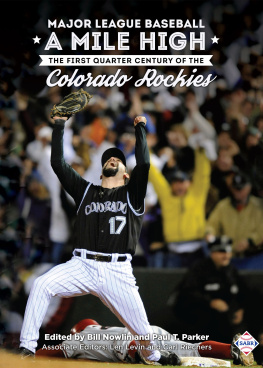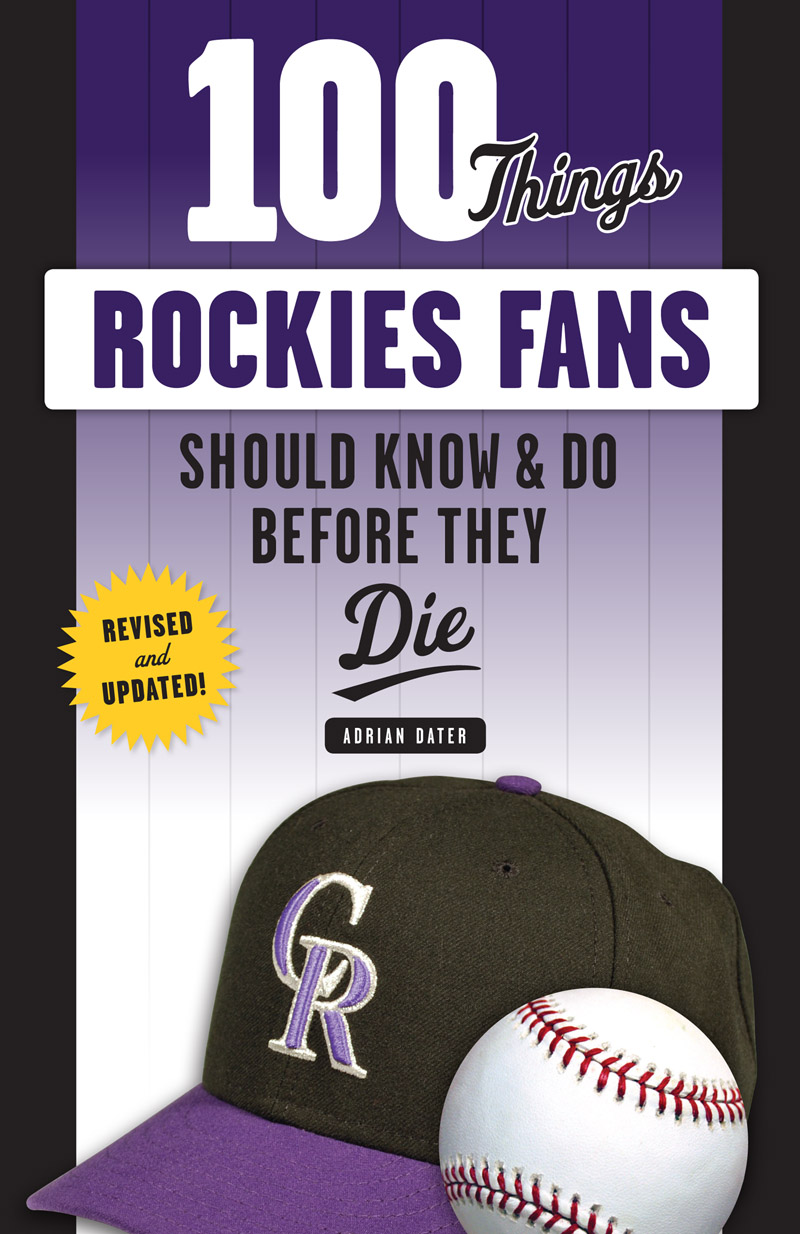
For Heidi and Tommy
Contents
Acknowledgments
It wasnt that long ago when it would have been considered a far-out hope of fiction to be able to write a full-length book about a major league baseball team in Colorado.
As the following pages will tell, it took a long time for a big-league team to become a reality in the Mile High City of Denver, and it is a pleasure to be able to recount much of the history of the teamso farhere.
This book would not have been possible without the help of many people. I am indebted to the following people for their recollections, guidance, and overall knowledge of the Rockies, their history, and other matters of baseball history: Jay Alves, Clint Hurdle, Matt Holliday, Todd Helton, Curtis Leskanic, Dante Bichette, Dale Murphy, Vinny Castilla, Aaron Cook, Walt Weiss, Brian Fuentes, Troy E. Renck, Drew Goodman, Mark Knudson, Thomas Harding, Brad Hawpe, Joe Torre, Larry Walker, Mike Klis, Woody Paige, Mark Kiszla, John Henderson, Jim Armstrong, and Irv Moss.
Thanks to Brandon Spano and the rest of the staff at BSN Denver.
Thanks to the reference librarians at The Denver Post for allowing me to sift through many rolls of microfiche.
And thanks, as always, to my wife Heidi and son Thomas Alan Michael for letting me disappear for hours at a time to the computer.
Introduction
Cowtown.
That was always the word for Denver. Denver hosted the Democratic National Convention in 1908. The National Football League Broncos played in Denver for the 1978 Super Bowl. The fictional family from the TV hit Dynasty called Denver home.
Big deal. Without baseball, critics said, it was and would always stay a Cowtown. Then, in 1993, Denver became Major League. Finally the Colorado Rockies were established and Denver had nothing to apologize for.
For about 40 years, Denver was nothing more than a bluff to Major League Baseball. It was always the city where If we dont get the new ballpark/tax concession/take your pick, were going to pack up and move to Denver bargaining chip baseball owners would use as a threat against their own city to get what they wanted. Teams from Oakland, Chicago, and Pittsburgh were each at one time considered sure things to move to the Mile High City. Before things could get serious, cities threatened striking up a new romance with Denver before politicians and fans caved to their owners.
It turned out that Denver never had to adopt. In 93, baseball awarded Colorado one of its two new expansion teams, and Denver acted like the 45-year-old parents who finally got their first child after years of trying. The love affair was intense, the civic pride intense. How intense, you ask?
Try a new major league record for attendance its first year at Mile High Stadiuma record that still stands and many believe will never be broken. Fans were so crazy hungry for baseball in Denver that they cheered the home team in games when it was down by 10 or more runsand those kinds of games occurred frequently that first year. In 1993, it seemed like all a Rockie had to do was put his uniform on correctly and the fans gave a standing ovation.
This book is a look at how big-time baseball made its long, twisted way into Denver, and what happened after it did. Like most love stories, the initial heat from the honeymoon with the Rockies in Denver gradually faded. Unthinkable those first couple years, boos can be heard in Denver now as often as most every other major league city.
But the foundation for a great relationship has endured to this day. As bad as the Rockies have been at timesand that is, very badthe people of Colorado have always been able to say, Yeah, but at least we have a big-league team here.
This book also takes a look at the many things that make Coloradowell, Colorado. If many of the people, places, things, and stories chronicled in the following pages didnt exist, then probably the Rockies wouldnt either.
In 1992, no Major League Baseball game had ever been played in the Mile High City. Fifteen years later, a World Series game between Colorados Rockies and one of baseballs most storied teams, the Boston Red Sox, took center stage. If that isnt proof enough that Denver is no longer a Cowtown, then nothing is.
1. FinallyA Team
On June 15, 1989, Major League Baseball commissioner Peter Ueberroth announced plans to expand by two teams some time in the near future. That set in motion a long, arduous, and complicated process by which the city of Denver tried to get one of the golden tickets of entry from the expansion committee.
Just about everybody who was anybody in Denver did something to help the bid. Governor Roy Romer solicited Colorados movers and shakers nonstop for financial support. Senator Tim Wirth made not-so-subtle hints of introducing legislation that might lift baseballs antitrust immunity. Denver Mayor Federico Pena wined and dined members of the committee, even giving Pittsburgh Pirates executive and committee member Doug Danforth a key to the city shaped like a baseball bat.
Denver wanted a big-league baseball team, and it wanted it badly. But nobody expected it to really happen. Denver had been burned too many times before with sure thing promises of a team, only to be used as a pawn. Denver became the threat any baseball owner could make to their own city to get a new stadium. If an owner wasnt getting his way, he would invariably play the Maybe well move to Denver trump card and invariably get his way.
The closest Denver came to getting a team was in 1977, when it looked like a done deal that the Oakland As would relocate there. A wire service report actually said the As had been purchased by Denver billionaire oilman Marvin Davis. But the deal fell apart when As owner Charlie Finley, going through a divorce at the time, had much of his assets frozen. Oakland Raiders owner Al Davis was also threatening to move his NFL team to Los Angeles (which happened five years later), and the city of Oakland started to give the As more concessions to keep them around.
Owners of the Chicago White Sox and Pirates also raised false hopes of Coloradoans that they would sell to Davis, who finally tired of being used and moved to Los Angeles to start a team in the USFL.
When Davis left, Denver was left with a void for the kind of financial heavy hitter who could bring in a Major League team, or so the skeptics said. The city had some people with money, but not the kind who could look at a big-league team as a toy.
Denver was starting to really transform itself in the early 1990s. No longer was it the boom-and-bust oil town of the past. Tens of thousands of young transplants poured into the city, lured by cheap real estate prices and jobs in burgeoning industries like telecommunications and computers. The lower downtown section of the city went from being a bowery-style district to one teeming with hip microbreweries and dot-com startups.
All of this impressed the eight-person MLB expansion committee, which came to Denver on March 26, 1991. The committee was composed of the Pirates Danforth, National League president Bill White, Mets executive Fred Wilpon, Phillies exec Bill Giles, NL senior vice-president Phyllis Collins, NL public affairs VP Katy Feeney, and two NL secretaries.
Denver didnt just roll out red carpets and hand out keys to the city for committee members. There were helicopter tours, marching bands, and about 5,000 people singing Take Me Out to the Ball Game outside the United Bank Center, where the group got down to serious discussions over Denvers viability.




